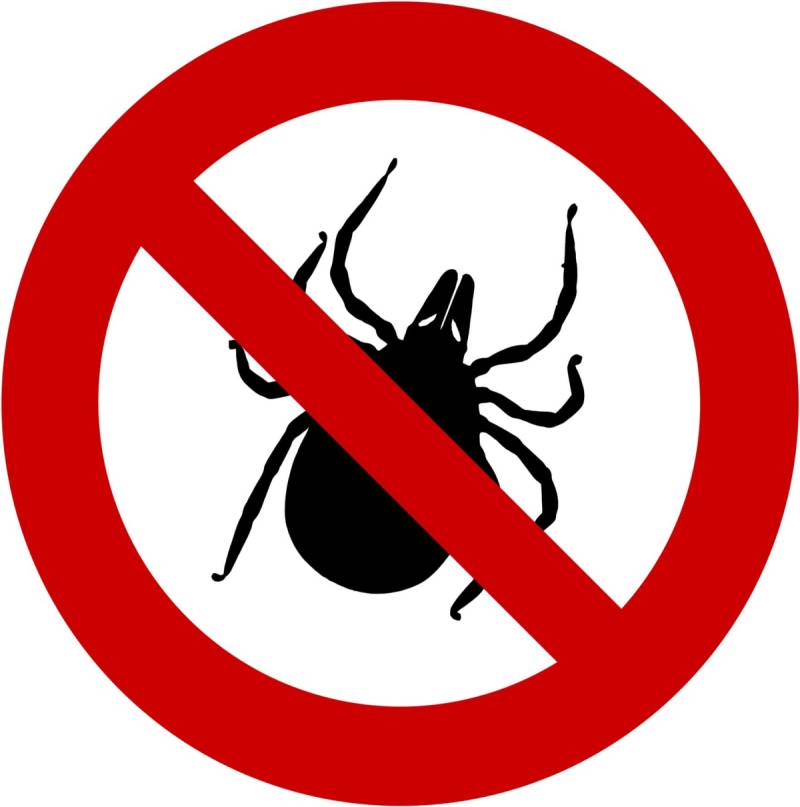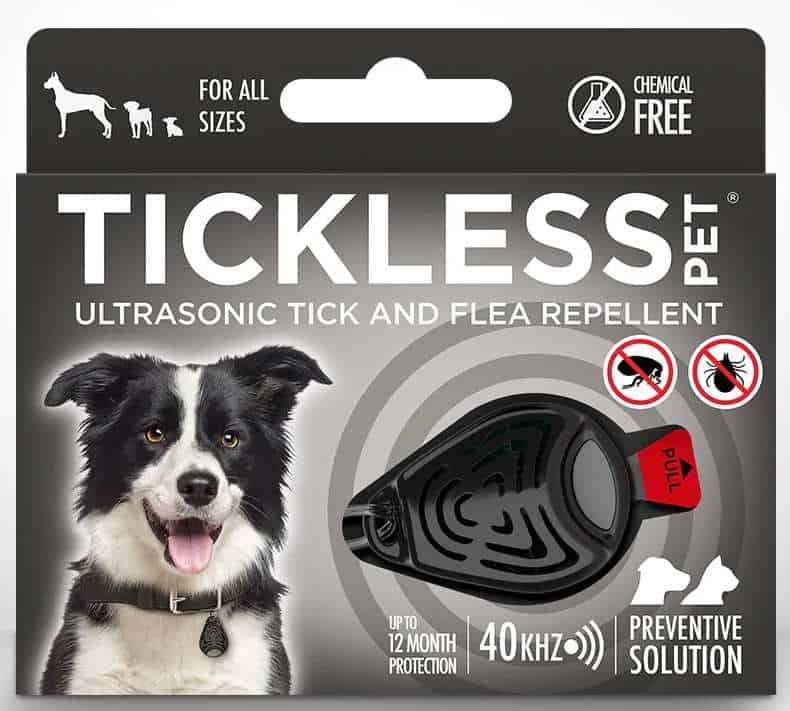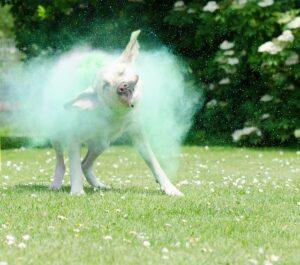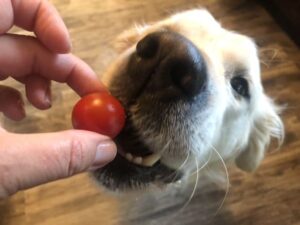15 Flea and Tick Solutions for Dogs
Oh those dreaded pests that wreak havoc and suffering in our dogs – fleas and ticks!
- Conventional flea and tick products are made from toxic chemicals and can risk the health of your pet – but you’re told it’s the most effective option.
- Natural products tend to be safer – but are they effective?
The decision can be agonizing.
Whether you’re considering conventional or natural solutions (or a little of both), find out your options here.
To make your decision easier, we’ve rated 15 natural and conventional tick and flea solutions in a convenient chart!
Tick Talk

Ticks are related to spiders, and feed off the blood of living beings. They have flat, oval bodies that engorge when filled with blood. Ticks live in grassy, wooded areas, piles of leaves or undisturbed nests and bird feeders and are hardy enough to survive in temperatures above freezing.
They can carry bacteria, viruses and parasites that cause illnesses like Lyme disease and Rocky Mountain spotted fever. Animals can pass on the bacteria and viruses to people and that can lead to serious illnesses.
Symptoms of Lyme disease in dogs can include: lameness, fatigue, fever, depression and kidney damage. Some can be treated with antibiotics, others are more difficult to treat. Fortunately, only 5-15% of dogs that test positive for Lyme show any clinical symptoms.
Flea Facts

These parasites live in tall grass and shaded areas until they’re ready to hop onto a warm-blooded person or animal. They don’t fly, but their sharp teeth and claws allow them to jump from one victim to another (up to 7 inches high and 13 inches horizontally).
Fleas consume blood and have flattened bodies to help them move through dog fur with ease. Flea bites cause red raised bumps and typically form in clusters. Not just a source of annoyance, they can lead to skin infections and even anemia.
Three Types of Tick & Flea Protection
Whether natural or conventional, there are three basic approaches to protecting your dog from ticks and fleas:
- Optimize your dog’s health. Dogs in excellent health have stronger immune systems and better overall protection and ability to fight infections naturally.
- Repel pests. These aim to repel ticks and fleas from being attracted to your dog. Most flea & tick solutions are in this category.
- Kill pests. Once ticks or fleas have landed on your dog, these solutions aim to kill them.
1. Optimize Your Dog’s Health
Despite the plethora of tick prevention products, the number of cases of canine Lyme disease has increased 40% over the past four years.
This might mean that our dogs’ immune systems are becoming more taxed and less able to manage tick-borne illness. Other theories are an increase in deer and mice population as well as climate change.
Although healthy dogs can still get fleas and ticks, you can give your dog the best shot at preventing pest infections by:
- priming a strong immune system
- supporting efficient digestion
- ensuring he has a variety of immune-boosting herbs, vitamins, enzymes and healthy fats through natural fresh sources
Dogs that are poorly nourished, have cancer, are immunocompromised, over-vaccinated or over-medicated are at greatest risk for secondary infections from fleas and ticks.
Let’s start with the cornerstone of optimizing your dog’s health – his diet.
Diet
The most important factor for optimal health is a fresh, whole food diet.
People underestimate the healing power of nutrition. But diet can be the number one factor in your dog’s heath.
Processed Dog Food (Kibble)
Conventional thinking suggests that kibble is enough for a healthy dog. Kibble products must abide by (low) standards of nutrition, mostly related to ratios of protein, carbs and fats, and the addition of vitamins. Most dog owners get their information from vets or breeders. Unfortunately, most conventional vets and breeders don’t receive sufficient training about nutrition, and can get their education directly from dog food companies. They are vulnerable to biased corporate research and kick-backs to supplement their income (we love vets and breeders and they deserve fair compensation for their work!). Their intentions may be good but, most conventional vets and breeders are just not experts in nutrition.
Let’s take a quick look at what’s in that bag of kibble:
- highly processed rendered meat that can include diseased or cancerous animals. “Rendering” means sanitizing sick or putrid meat so that it can be cooked and sprayed with oil to make it palatable
- grains that are genetically modified and saturated in pesticides. Even “grain-free” kibble has high starchy carbs like pea protein, legumes or potato
- low moisture ingredients that put a dog into a state of chronic dehydration
- preservatives to prevent fats from becoming rancid
- synthetic vitamins to meet minimum standards to sustain life
Feeding kibble to a dog is like eating fast food at every meal for your entire life.
Natural, Whole Foods
 A fresh meat-base diet (including organs and bone) with blended vegetables and healthy fats is a superior diet for the majority of dogs.
A fresh meat-base diet (including organs and bone) with blended vegetables and healthy fats is a superior diet for the majority of dogs.
When owners say their dog won’t eat despite trying different brands of kibble, we say “listen to the dog” and give them real food.
Now, some dogs may need fresh meats to be cooked gently if they have serious illnesses like cancer (never give dogs cooked bones, they are a choking hazard). Preparing fresh food may take more time and effort, but persevere – your beautiful fur soul is worth it.
At minimum, a healthy diet that supports good immunity and digestion must include:
- B vitamins (found in most meats, organ meats, oily fish, eggs)
- Probiotics (goat kefir, fermented vegetables)
- Sulfur-containing foods (eggs, steamed cabbage, broccoli, Brussels sprouts, cauliflower)
- Omega-6 fatty acids (poultry, eggs, flaxseed, hempseed)
- Omega-3 fatty acids (mackerel, freshly ground hemp & flaxseed)
2. Repel Fleas & Ticks
Conventional Pesticides
Let’s start with the standard topical (on the skin) and oral pesticides commonly prescribed by conventional vets. These tick and flea products are chemical pesticides that work in two ways:
- When a topical medication is applied (e.g. on the fur, or through a collar, shampoo or powder) it deposits pesticides that repel ticks away from your dog
- When a dog is given oral chemicals, the pesticide stays in his body so that when ticks bite, they ingest the pesticide and die
Since they are commonly given to repel and kill pests, we’ll talk about both functions together.
These products have been shown to be somewhat effective in preventing and killing fleas and ticks, however dog parents must weigh the potential risks and side effects. A number of dogs have experienced skin irritation, drooling, tremors and seizures and there have been federal warnings issued about the toxic effects of particular drugs used in some products.
Never use tick or bug repellants on dogs that are meant for humans, especially those with DEET
Long Term Use
Many drug studies don’t look at the cumulative effects of seasonal medications like vaccines, flea & tick products. However, we do have some data on the long term use of flea & tick pesticides. Some potential health problems include:
- nervous system and thyroid toxicity, including cancer
- liver and kidney damage
- seizures
- reduced fertility, fetus death and low birth weight puppies
- tremors, itching, barking, hair loss, loss of appetite
- less effectiveness as fleas and ticks become resistant to these pesticides.
When specific chemicals were studied, two additional effects were observed:
- when these products (or your dog on these products) are exposed to the sun, toxicity rates rise up to 10 times.
- spot-on flea & tick products that contain the chemical pyrethroid were linked to 1,600 pet deaths and 90,000 adverse reactions including brain and heart damage. This chemical is considered a human carcinogen, yet they’re freely sold for use on our sensitive fur souls.
Only 66% of dog owners reported being happy with pesticide products.
We don’t use conventional pesticides on our dogs, but if you decide to do this:
- purchase them from a licensed vet
- read directions very carefully – a dog’s weight, age and dosing is critically important to minimize side effects and health hazards.
- check the FDA warnings about the specific products you are considering
- monitor your dog very carefully
- if your dog gets side effects, ask your vet to report them. Adverse effects from chemical treatments and vaccines are underreported, leading to a false sense of security about safety.
Natural Flea & Tick Repellants
There are several ways to go natural and still avoid fleas and ticks! Use a combination of these solutions to optimize your dog’s protection.
Spices
 Think we’re suggesting your dog has a palette for Indian, Asian or French cuisine? Not exactly, these spices are not used for taste, but rather for their therapeutic benefits in repelling pests.
Think we’re suggesting your dog has a palette for Indian, Asian or French cuisine? Not exactly, these spices are not used for taste, but rather for their therapeutic benefits in repelling pests.
Garlic
Some people believe that fresh garlic is toxic to dogs. That’s a myth (unless your dog is eating huge amounts). It would take a whole clove of garlic per pound of dog to approach toxic levels (for a 95 lb dog, that’s about a dozen bulbs).
In fact, using the proper amount of this spicy vegetable (yes it’s technically a vegetable!) can help your dog to repel fleas, ticks (and mosquitos) naturally. Research indicates that garlic’s effectiveness at repelling pests may be due to activation of allicin, garlic’s medicinal enzyme. This is why it must be prepared properly.
At the start of tick season, adding small amounts of garlic to a whole food diet may offer a degree of protection from ticks.
How to give your dogs fresh garlic:
- Finely dice or crush fresh, organic garlic cloves
- Leave out for 10 minutes prior to adding to your dog’s whole food raw or cooked diet. A short waiting period allows freshly chopped garlic to activate allicin, its medicinal enzyme. Small dogs can eat up to one clove per day; large and giant breeds may have up to two cloves per day. Start with low amounts. Remember, you want a clove, not a full bulb!
Add fresh garlic daily for 2 weeks, then twice a week for maintenance.
If your dog becomes gassy, back off on the garlic – this may indicate he has some underlying digestive issues that should be addressed.
Hint: When you’re using fresh garlic for flea and tick prevention, avoid detergent based shampoos on bath day. Only use Castile soap-based dog shampoo or other safe shampoo so you don’t strip the garlic essence from his fur. If you have to bathe your dog during tick season, restart the garlic protocol.
Turmeric
This bright yellow pungent spice is well-researched for its anti-inflammatory properties. It is often used for conditions where inflammation is high, such as arthritis. Although it can be sprinkled lightly over food, or given in capsule form, studies on its use in tick prevention have been based on the oil of turmeric.
Hint: Turmeric’s sunshiney colour will stain the hands, and even the oil has a yellow colour, so we have not included it in the tick blend recipes below. If you want to add this natural bug repellant to your essential oil spritz, just add 3-4 drops to either recipe. Check out our homemade flea and tick spray recipes. The recipes should be diluted enough to avoid turning your blond dog brassy (but try it on your hands first).
Apple Cider Vinegar (ACV)
ACV can be helpful for a range of conditions and some people suggest it can help repel fleas and ticks when diluted and spritzed. The evidence is not robust, however the theory is that it makes your dog’s skin/fur slightly acidic and that’s what repels or kills ticks and fleas.
If you want to give this one a try, make sure you dilute the vinegar well.
- 125 mL (4 oz or 1/42cup) organic unfiltered apple cider vinegar
- 250 mL (8 oz or 1 cup) filtered water
- 1/4 tsp Himalayan or sea salt
Put ingredients in a dark glass spray bottle and spritz legs, belly and base of tail weekly. Monitor for any skin reactions.
If any natural product smells strong to you, don’t put it on your dog. Dip your hands in the solution and pet your dog’s tick-prone areas. If he doesn’t shake, lick, run or become restless, you can use a little more. Never put vinegar on an open cut or sore.
ACV can be used internally as a therapy to adjust the ph level of your dog’s body, however consult a holistic vet or pet care specialist first. If adding medicinals to your dog’s water, always have an additional bowl of pure filtered water available.
Herbal Formulas
Herbal flea and tick products aim to support a dog’s inner immune and digestive health to enhance resistance to pests. EarthMD’s Outdoor Shield is a herbal product that we have used as part of our Holistic Flea & Tick Prevention Program. It blends Quassia bark, Neem leaf, garlic and spirulina in a powder sprinkled over your dog’s food. Given daily for a week, every other month during flea and tick season, these formulas can offer some protection, however the level of protection is somewhat dependent on the dog’s level of health and diet. It is certainly safer than conventional pesticides, and those herbs are well researched.
Essential Oils
Essential oils can be powerful and effective. Ticks and fleas tend to avoid certain scents, making the appeal of an essential oil spray seem natural and safe.

There is evidence that certain plant-based oils have bug repellant properties. Ticks, fleas and other pests will often avoid the scents of lemon, orange, cinnamon, lavender, peppermint and rose geranium.
But, there are three concerns with essential oils.
- Not all oils are created alike. Low quality oils (or worse, oils with added “scents”) are not much better than harsh chemicals and pesticides. Look for lab tested, organic oils.
- Oils can harm the dog if used in the wrong way. When applied to the skin or fur, oils can cause skin irritation. When sprayed, they can get into a dog’s sensitive nose, mouth or eyes causing irritation, burns and distress.
- Dogs may be tempted to lick off the scent, taking those oils into their bodies and potentially causing liver problems.
Having said this, if you use high quality oils properly, they can be quite effective in deterring pests. Check out all our homemade flea & tick essential oil recipes. Here are three of our favourite blends to get you started.
Three Recipes for Homemade Flea & Tick Repellants
Harley’s “Spritz Off!” Tick Spray
Blend and shake these (gently) in a dark or opaque spritz bottle. Makes about 8 ounces.
- 1 tsp vegetable glycerin
- 1/2 ounce grain alcohol or vodka
- 1 tsp sulfated castor oil
- 10 drops grapefruit seed extract
- 7 ounces distilled or spring water
- 2 drops geranium essential oil
- 2 drops rosewood essential oil
- 3 drops lavender essential oil
- 2 drops opoponax essential oil
- 1 drop bay leaf essential oil
Denver’s “Ba-Bye Ticks” Essential Oil Blend
Blend and gently shake these in a dark glass dropper bottle. This will be a powerful blend and you only need 2-4 drops applied to the chest, legs and base of tail. We like to try it first by adding 2 drops to a bandana. If your dog doesn’t like it, it’s easy to remove. Alternatively, add a few drops to your hands and massage gently into your dog’s legs, underside and under his tail.
- 1 1/2 ounces base oil e.g. sweet almond oil (never leave out a base or carrier oil)
- 2 drops geranium essential oil
- 2 drops rosewood essential oil
- 3 drops lavender essential oil
- 2 drops myrrh essential oil
- 2 drops opoponax essential oil
- 1 drop bay leaf essential oil
Fern’s “Please Leave Me Flea Fighter” Essential Oil Blend
- 1 ounce carrier oil
- 3 drops lavender essential oil
- 2 drops lemon essential oil
- 2 drops cedar essential oil
- 2 drops clary sage essential oil
- 1 drop peppermint essential oil
Apply before walks and hikes by spraying (or putting a few drops on) your hands first, then gently rubbing dog’s tick-prone areas like chest, legs and base of tail (stay away from mouth and eyes). Start with a very small amount. If your dog doesn’t lick, run, become restless, sneeze or act in an unusual manner, you can add a bit more. We suggest that you start by putting a bit on a cotton bandana to see how your dog reacts. Remember – if you can smell it, it smells thousands of times stronger to your dog.
For more recipes please check out our homemade Recipes for Flea and Tick Sprays.
Amber Collars & Pet Charms
 Although it’s still not clear how effective raw, natural amber is for flea and tick prevention, amber can be a beautiful addition to your flea & tick prevention program if you’re looking for doggy bling and “maybe” some protection.
Although it’s still not clear how effective raw, natural amber is for flea and tick prevention, amber can be a beautiful addition to your flea & tick prevention program if you’re looking for doggy bling and “maybe” some protection.
The theory is that amber (like essential oils) contain terpenes that emit a very subtle resinous scent when warmed up by your dog’s fur. These terpenes are thought to repel ticks and fleas from settling into the skin. Amber is also believed to generate a static electrical charge when rubbed against the fur. Research is very limited, and success stories are typically case reports or testimonials. Supervise stones and necklaces around pets, and don’t use where dogs or children can present a choking hazard.
Pest-Resistant Environments
Quite simply, this is how to make your dog’s outdoor space unappealing to pests:
- Keep lawn trimmed short, remove piles of leaves and low brush
- Plant lemon balm, sage, rosemary, lemongrass, basil and mint outside
- Sprinkle some diatomaceous earth (DE) outside patio doors (we’ll talk about DE later)
- Spray your yard lightly with a mixture of garlic steeped in boiled water (strained first)
- Sprinkle your indoor floors with diatomaceous earth once a month. Leave on for 48 hours, then vacuum
Chemical Free Flea and Tick Repellants: Ultrasonic Devices and Metal Tags
These products are believed to emit small amounts of energy, disorienting to fleas and ticks.
- Ultrasonic devices emit short ultrasonic pulses that disorient fleas and ticks so that they fall off and never have the chance to bite your dog. They are chemical-free and last for an entire flea and tick season. Research has shown that ultrasonic tick repellents are effective and have no side effects. Read our full review of Tickless ultrasonic repellents.
- Metal tags claim to deter fleas and ticks by working with a dog’s energy through encoded frequencies meant to deter pests and support the dog’s natural immune system. Neither testimonials nor science is robust enough to recommend these as a sole flea and tick solution.
Good Old Daily Grooming
Every dog owner should be checking their dog daily and removing ticks immediately. Checking a large, very furry dog can be time consuming, so make it a fun time to massage and love up your pup after walks!
- Look in his ears and mouth including his gums, tongue and jowls. Dogs have been known to have ticks attach to their mouths and gumline when they are chewing grass or plants. Double check common tick-hiding spots like under the tail, between the toes, between the back legs near the groin and behind the front legs.
- Brush, comb and groom your dog daily, parting the hair to examine the skin. If you find a tick, remove it carefully and bring it to your vet to identify if it’s a disease-carrying tick.
- Keep checking skin for a month after finding a tick, looking for red ring rashes or other irritations. If you suspect a tick may be carrying the bacteria for Lyme Disease, consider using Ledum Palustre immediately to lower the risk of infection.
- Buy a tick removing tool so that it’s on hand when you need it (clip it on to the handle of your leash for those long hikes).
How Do I Know if My Dog Has a Tick or Flea?
- Ticks. Ticks may not cause excessive itching – you may not even notice it until you’ve groomed your dog, checked his gums or ears or felt the tiny bump of an engorged tick when you pet him
- Fleas. If your dog is scratching or biting its fur, this is a good time to do the Flea Test.
Flea Test
Place your dog on a damp white towel or paper towels and comb through his hair. Look for brown or red marks (not black or grey) on the towel. There’s no other way to say this – it’s flea poop with your dog’s blood in it. Sorry, but your dog has passed the Flea Test – and that’s not a good thing.
Once you find a tick or flea, you have some extra work ahead. But there are safe, effective, natural options – so don’t panic.
3. Kill Pests
We’ve already covered conventional pesticides, since they are used to both repel and kill ticks and fleas. Here are some natural alternatives.
Diatomaceous Earth (DE)
Sometimes called the “natural tick & flea killer”, DE is a type of sand that contains fossilized algae. It occurs naturally and is a concentrated source of silica. DE literally pulls water out pests on contact, instantly killing it, without harming the dog. Always use food-grade DE to avoid the toxins in industrial DE.
How to Kill Fleas & Ticks with DE:
- Sprinkle food-grade DE into your dog’s coat and rub his coat throughly, especially in areas pests can hide. Fair warning – do this outside and be prepared for a cloud of white powder and some dry fur. Poofs of DE dust can look particularly amusing on a dark coloured dog! We recommend you take DE if you camp – it’s a fantastic preventative when you’re already a little dirty.
- If you’re dealing with a flea infestation, you’ll need to “DE” your home. This means sprinkling DE on all the floors and your dog’s bedding, leaving for 48 hours, then vacuuming up. Add a line of DE to the bottom of doorways to catch fleas and ticks from coming into your home.
Recommended Diatomaceous Earth
Homeopathic Remedies
These are usually used once a dog has been exposed to a flea or tick. The purpose is to prevent a bacterial, viral or parasitic infection from turning into disease. The science of homeopathy is well researched and has been used for thousands of years to improve the vital energy of people and animals. Homeopathic remedies can be purchased in health/natural food stores and in some pharmacies.
- After removing a tick (or as soon as you notice fleas), use Ledum palustre to help prevent bites from developing into Lyme or other serious diseases.
- TIP: Homeopathic remedies come in the form of small pellets. It is vital not to touch these pellets with your hands. The container allows you to turn the cap to release the right number of pellets into the bottom of the cap. It is very difficult to drop the pellets directly into your dog’s mouth and allow it to dissolve, so we suggest tapping 3 pellets into 4 ounces of distilled water, let it dissolve, stir and syringe 1 cc into your dog’s mouth or pour onto a teaspoon and give. Exact doses and concentrations aren’t absolutely essential for this traditional energy medicine.
- Ledum comes in different potencies. The highest potency and the one most researched for dogs is 1M. However, other potencies like 30c or 200c can also be used.
At the first signs of a tick, flea or pest bite:
- give 3 pellets of Ledum palustre 1M (or follow directions on bottle for lower potencies) right away
- continue dosing with Ledum every three hours for the first 24 hours
- then dose twice a day for one week
- after the first week, dose twice a week for one month
- after that, dose once per week for one more month
Herbs
Once a disease is established, such as Lyme disease, herbs can be a natural option to treat the infection with fewer side effects than conventional antibiotics. Evidence is building that conventional antibiotics like doxycycline does not stop Lyme disease from progressing, and can hinder the dog’s natural defence mechanisms.
Only 5-15% of dogs who test positive for Lyme disease show symptoms – this may indicate the dog’s natural immunity is managing the infection.
- Astragalus, buffered vitamin C, silver, other homeopathic remedies and a superior diet are treatments for established diseases like Lyme. Talk to your Holistic Vet or Canine Herbalist to discuss the best options.
Chemical Flea Products
In the case of severe flea infestations or where a dog is suffering, these pesticides can be used as a last resort to kill fleas.
The Bottom Line
How Do I Decide Which Flea & Tick Solutions to Use?
The answer boils down to this:
- effectiveness
- safety & side effects
- ease of use
- cost
- the overall health of your dog
- research and testimonial evidence
- preference toward natural, conventional or both
There is a time and place for both natural and conventional approaches to your dog’s health care. Our chemical-free Holistic Flea & Tick Prevention Program starts with essential oils, an immune-boosting diet and an ultrasonic pest repellant like Tickless.
Top 15 Flea & Tick Solutions: Rated
We’ve made your decisions easier with this useful table!
We’ve summarized each solution based on the above criteria, highlighted some pros & cons and given each one a final score from 0-5.
- In our opinion, a score of “0” is something to avoid at nearly all costs
- A score of 2-3 is worth considering and could be quite effective when used in conjunction with other strategies
- A 4-5 is a “top dog” score
| Flea and Tick Solution | Tick Solution Score (0-5) | Flea Solution Score (0-5) | Pros | Cons |
| Fresh Whole Foods Diet | 4 | 4 | Improves overall health & natural immunity | Slightly more time & effort |
| Processed Diet | 1 | 1 | Easy, inexpensive | Can result in poor overall health & low resilience to disease from fleas & ticks |
| Garlic | 4 | 4 | Deters fleas & ticks | Takes a little extra time to prepare |
| Turmeric | 2.5 | 1 | Inexpensive, may deter ticks | Turmeric can stain skin |
| Apple Cider Vinegar Spray | 2.5 | 2.5 | Can shift ph levels & may repel pests | Can smell unpleasant |
| Herbal Formulas | 4 | 4 | Easy to use, may help repel bites | Not 100% effective, but no products are |
| Essential Oils | 4 | 4 | Can repel fleas & ticks | Can hurt skin/nose if not used appropriately |
| Amber | 2 | 2 | Might help; looks nice | Relatively expensive, choking risk, low evidence |
| Ultrasonic Pest Repellants | 5 | 5 | Effective & safe | $40 USD per season; not waterproof |
| Environmental Measures | 4 | 4 | Prevents fleas & ticks from entering house/dog | Takes some time & effort |
| Diatomaceous Earth | 4.5 | 4.5 | Safe & highly effective to kill pests | Can be messy |
| Chemical Pesticides | 1.5 | 1.5 | Easy to use, may help to treat serious cases | Expensive, toxic side effects; unknown long term effects |
| Commercial insect repellents for people – especially DEET | 0 | 0 | Nothing. Never use these on dogs. | Chemical burn, liver damage, cancer. |
| Homeopaths After Exposure | 4.5 | 4.5 | Effective, safe, inexpensive | Requires dosing several times a day at first. |
| Herbs After Exposure | 4.5 | 4.5 | Effective, inexpensive, safe | May not be necessary if no disease transmitted by tick/flea |
We recommend discussing all health care options with your Holistic Vet and dog’s health care team.
Be kind to all living beings. Respect the earth we share. 
Join us on:








